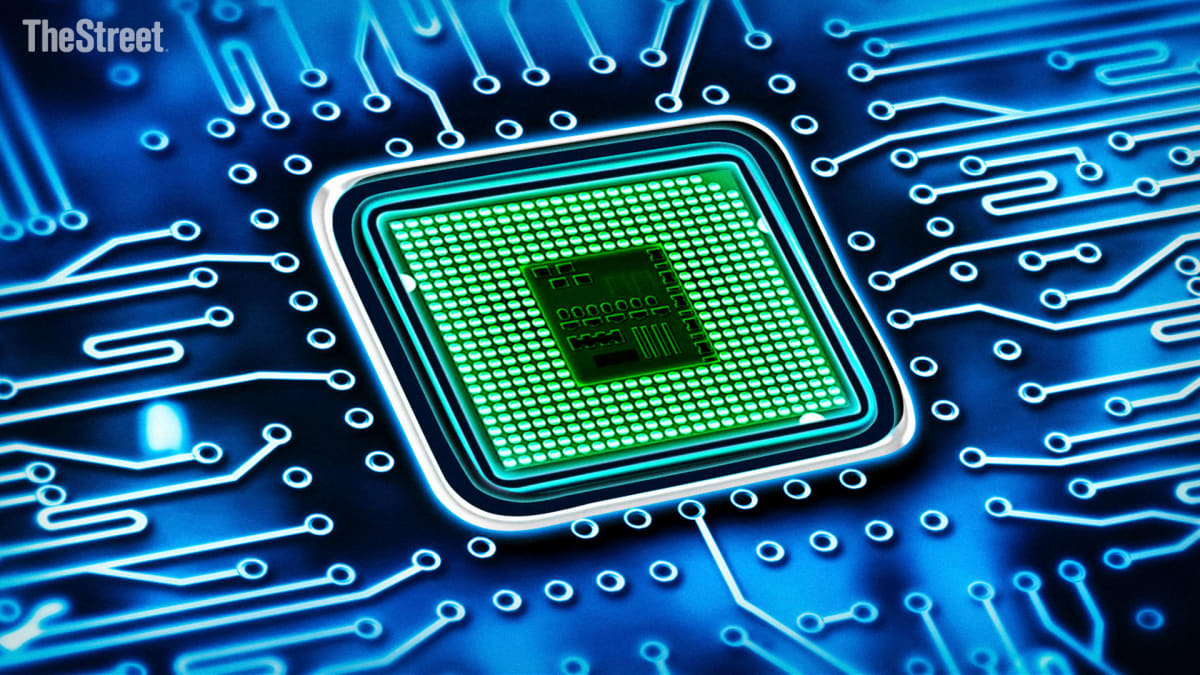
Intel INTC has become one of the world's most iconic businesses, yet it's facing some upcoming storms that won't be easy to navigate.
America's largest semiconductor designer and manufacturer has for years made the "Intel Inside" chips that go into personal computers. It expanded into providing higher-performance chips that powered corporate datacenters, while also pursuing sexier new applications like neuromorphic computing, quantum computing, and field programmable gate arrays. Intel is a truly global organization; it has 120,000 employees, hundreds of thousands of active patents, and a commitment from the very top ranks to be innovative.
Yet the company -- whose very founder Gordon Moore pioneered "Moore's Law" to suggest transistor density would double every two years -- has perhaps become a victim of its own success.
Do you want your portfolio to outperform the market? Our lead advisors uncover the top 7 opportunities in the stock market each month for our members. Click here to try 7investing for $1.
Even with its commitment to innovation, Intel has fallen behind several of its competitors in chip design in recent years. ARM Holdings, who is currently owned by Softbank but has hinted at going public in the near future, has more than 90% market share when it comes to the architectural design for energy-efficient Smartphone chips. And within the corporate datacenter, computationally-heavy artificial intelligence workloads have led customers to higher-performance processors offered by NVIDIA NVDA and AMD AMD. NVIDIA's A100 GPUs are "AI accelerators" that are able to compute AI code more efficiently in parallel rather than in series. AMD's Epyc CPUs have a fundamentally redesigned architecture that has vastly improved their computing efficiency.
This flood of innovation has made it challenging for Intel to keep up in design, as deep-pocketed cloud computing customers like Amazon AMZN, Microsoft MSFT, and Alphabet GOOGL have voted with their wallets. NVIDIA's data center revenue is growing at 61% right now ($3.8 billion in its most recent quarter) and AMD's is growing at 45% ($1.6 billion in its own). Meanwhile, Intel's data center sales fell by 27% (to $4.2 billion). There is a sign it is clearly ceding share to competitors on the design front.
Opening the Expansion Spigot
To counteract its design losses, Intel hopes to contract out its fabs to manufacture others' chips. Its new Intel Foundry Services takes the design plans from customers and manufactures at spec for the lowest cost possible. IFS is reaching an annual run rate of nearly $700 million and has recently won contracts from MediaTek and Qualcomm. Fabs are quite expensive to build, so Intel wants to offer some of its manufacturing capacity to produce chips for others.
This is quite different than the direction the semiconductor industry has headed for the past two decades or so, as most companies have looked to lighten up on their balance sheet by avoiding internal manufacturing. AMD spun-off its GlobalFoundries GFS manufacturing division back in 2009 so it could have an asset-light model that focused exclusively on design. NVIDIA and ARM always focused exclusively on design and never had their own manufacturing.
And downstream of the design process, the world's largest chip manufacturer Taiwan Semiconductor TSM has always remained independent and has focused on optimizing its own process technologies in order to produce cutting-edge chips in massive volumes for others. Taiwan Semi doesn't create or sell any of its own internally-designed chips.
Geopolitical Storms Are Brewing
Yet Intel believes the world is becoming a riskier place and that geopolitical storms are brewing. And it's probably right about that.
It's no surprise that China has ambitions of annexing Taiwan. Absolutely no one (at least without a security clearance) knows what military force in that situation would mean for China, Taiwan, the Western world, or Taiwan Semi's existing production contracts. Intel CEO Pat Gelsinger has been relentlessly campaigning to the US, Germany, and elsewhere that Intel's American-based manufacturing facilities would offer supply security even in the era of rising geopolitical tensions. In those same conversations, Gelsinger has asked for Federal grants and funding -- such as from the Biden administration's CHIPS Act -- to support America and its allies in ways that would secure the supply of their most advanced chips and serve national interests.
Intel recently broke ground on its Ohio-based "mega fab", which will cost $20 billion in its first phase and potentially up to $100 billion in total. The CHIPS Act has committed $3 billion of Federal funding for the first phase and potentially up to $6 billion in total. The project will also include job creation and funding for regional education.
Other large corporate clients might also follow suit as well. Could Apple AAPL, Qualcomm QCOM, and other innovative tech companies also be similarly-interested in domestic supply as well? Apple is Taiwan Semi's largest individual customer and alone accounted for more than $15 billion of TSMC's total revenue last year (26% of its top line).
Show Me the Money?
But between Intel's loss of market share in the corporate datacenter, the looming recession that's causing a slowdown in demand for PCs, and its aggressive fab expansion plans, Intel finds itself strapped for cash.
The company's balance sheet currently has $22 billion in cash and short term investments. That might sound like a lot, but it's down significantly from $40 billion at the beginning of 2022.
One fresh source of capital has been the recent IPO of Mobileye MBLY. Intel acquired Mobileye back in 2017 for a cool $15.3 billion, though it spun it back out to the public markets this past month at a $17 billion valuation.
Mobileye's valuation has risen only modestly; up 11% from $15 billion to $17 billion over that a five year period. Still, the public offering provided Intel with $861 million of new capital to work with.
Tough Decisions to Be Made
Intel has also committed to trimming some of the fat internally. It announced up to $10 billion in total cost reductions during the next three years, in preparation for the slowing PC demand and in response to the falling sales in several of its divisions.
And then, there's the curious question of what to do with the dividend.
Even though thousands of Intel employees will likely be losing their jobs through 2025, Intel has fully committed to paying out its $6 billion annual cash dividend in full.
The company undoubtedly wants to keep the dividend intact in order to continue to appeal to its institutional investor base. There are hundreds of millions of Intel shares in the accounts of Vanguard, Blackrock BLK, and several other institutional funds. Vanguard and Blackrock together own around 16% of Intel's outstanding shares, and the dividends from those shares are providing much-needed retirement income for 401K and IRA plans.
Yet one can't help but wonder if now is the right time to rip off the Band-Aid? For its aggressive expansion plans or for the sake of its own employees, perhaps Intel should consider cutting or reducing that $6 billion annual dividend.
The 7investing Key Takeaway
Intel is one of the most fascinating companies on the planet. It helped create the world's fast-moving semiconductor industry, which has in turn enabled massive trends like Smartphones, cloud computing, and artificial intelligence. Competition and global tensions are both rising, and Intel will need billions of dollars to steer its juggernaut chip ship into unchartered waters.
Those waters will have a lot of turbulence, and navigating them won't be easy. The decisions that Gelsinger and his leadership team make within this coming year will have significant implications for Intel's long-term investors.







